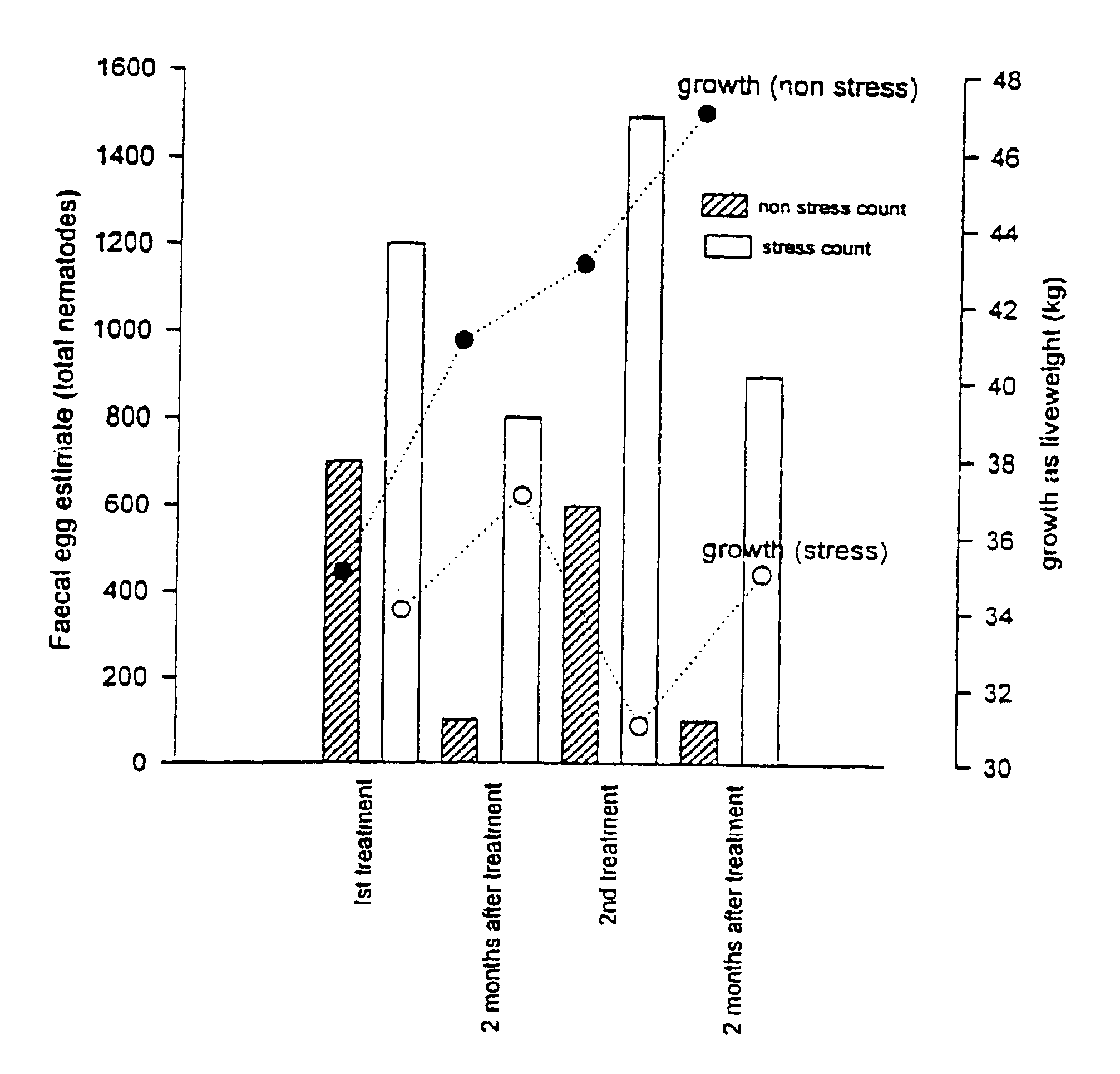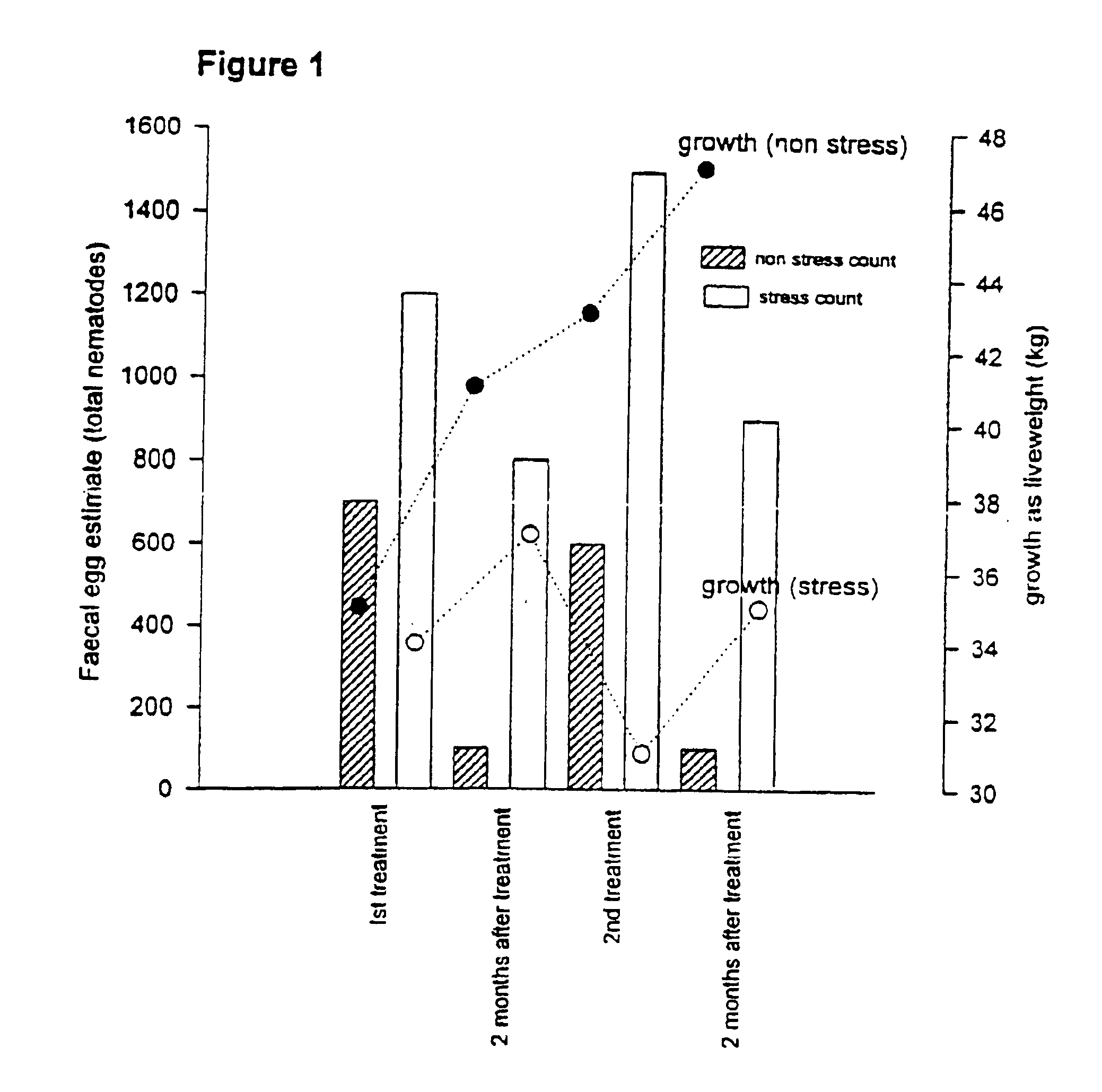Agents and methods for promoting production gains in animals
a technology of agents and methods, applied in the field of agents and methods for promoting production gains in animals, can solve the problems of poor growth, easy infection and reinfection, poor growth, etc., and achieve the effect of reducing the stress experienced by the animal and promoting production gain
- Summary
- Abstract
- Description
- Claims
- Application Information
AI Technical Summary
Benefits of technology
Problems solved by technology
Method used
Image
Examples
experiment 1
One half of the pairings were rounded up once a week and run through a race (control group). Any normal farm maintenance that was needed was done at this time, so that the time that animals may have been held was variable from week to week but consistent across the entire group and with the experimental group (see below). Faecal samples were also collected and both total egg and nematode egg counts calculated, and visual inspection for ectoparasites made.
The other half of the pairings (chronic stress group) were exposed to the same handling three times a week (consistent with the single weekly procedure above) and in addition to this were run around a paddock by either a human or dog (alternating) for 10 minutes. In this manner a mild, chronic, handling stress was imposed on these animals. Races and handling facilities were cleaned between animal movements to avoid any risk of parasitic contamination.
Animals were subject to the same anthelmintic treatments consisting of three pour-o...
experiment 2
In a similar parallel experiment the control group was identical and the paired group to this control (acute stress) received identical treatment to the control group and in addition an acute stress one day prior to anthelmintic treatment. This consisted of chasing the group three times during the day with a dog for 15 min duration each time. The faecal egg count and ectoparasite assessment was the same in both groups at time of the first experimental anthelmintic treatment. Anthelmintic treatment was administered at the same dosage as one of the four monthly treatments above and then faecal eggs counts followed for up to 6 months, with no further treatment. At average nematode counts of 600-700 treatment is recommended. It can be seen from FIG. 2 that the knock down time (time following the treatment in which egg counts were maintained below this acceptable number) was less in the acute stressed group. Again growth rate was less in the stressed group.
For both experiment 1 and 2 eac...
experiment 3
In a similar set of experiments to experiment 1, the animals in the chronic stress group also all received a chemical substance metyrapone (in an oral form at 5 mg / kg live weight) at the time of anthelmintic treatment. This substance is known to suppresses some of the physiological stress responsiveness, including elevation of levels of the glucocorticoid hormone cortisol.
Animals that received this treatment showed the same efficacy of anthelmintics as the non-stressed groups and similar growth rates. FIG. 3 illustrates this data.
PUM
| Property | Measurement | Unit |
|---|---|---|
| temperature | aaaaa | aaaaa |
| temperature | aaaaa | aaaaa |
| time | aaaaa | aaaaa |
Abstract
Description
Claims
Application Information
 Login to View More
Login to View More - R&D
- Intellectual Property
- Life Sciences
- Materials
- Tech Scout
- Unparalleled Data Quality
- Higher Quality Content
- 60% Fewer Hallucinations
Browse by: Latest US Patents, China's latest patents, Technical Efficacy Thesaurus, Application Domain, Technology Topic, Popular Technical Reports.
© 2025 PatSnap. All rights reserved.Legal|Privacy policy|Modern Slavery Act Transparency Statement|Sitemap|About US| Contact US: help@patsnap.com



